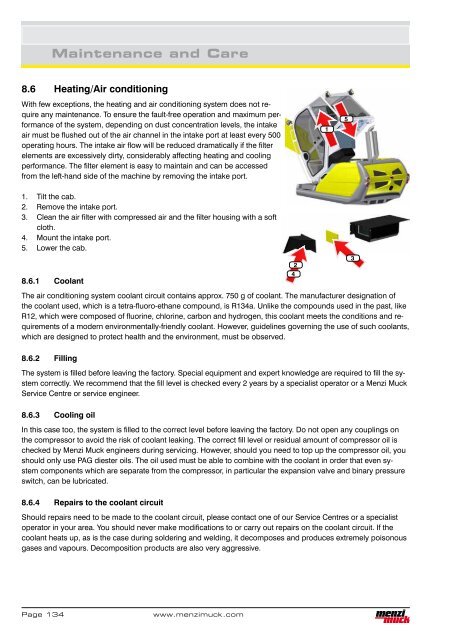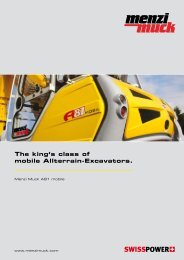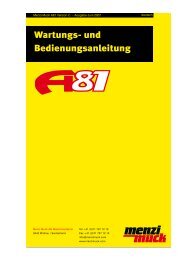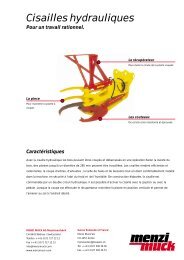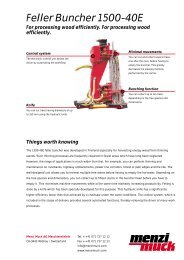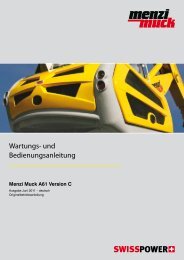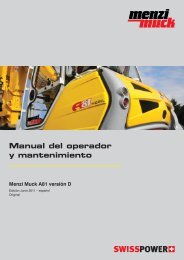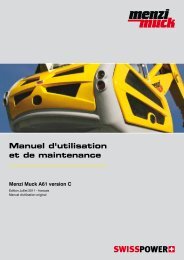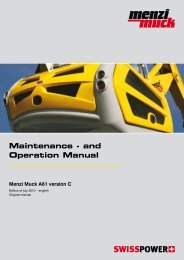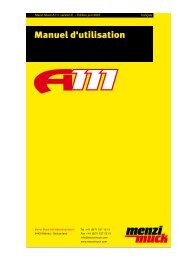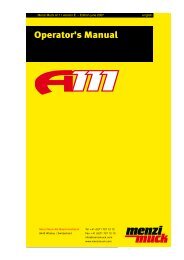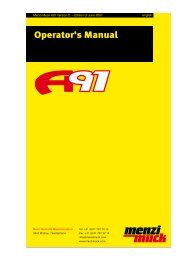Maintenance and Care
Maintenance and Care
Maintenance and Care
Create successful ePaper yourself
Turn your PDF publications into a flip-book with our unique Google optimized e-Paper software.
<strong>Maintenance</strong> <strong>and</strong> <strong>Care</strong><br />
8.6 Heating/Air conditioning<br />
With few exceptions, the heating <strong>and</strong> air conditioning system does not require<br />
any maintenance. To ensure the fault-free operation <strong>and</strong> maximum performance<br />
of the system, depending on dust concentration levels, the intake<br />
air must be flushed out of the air channel in the intake port at least every 500<br />
operating hours. The intake air flow will be reduced dramatically if the filter<br />
elements are excessively dirty, considerably affecting heating <strong>and</strong> cooling<br />
performance. The filter element is easy to maintain <strong>and</strong> can be accessed<br />
from the left-h<strong>and</strong> side of the machine by removing the intake port.<br />
1. Tilt the cab.<br />
2. Remove the intake port.<br />
3. Clean the air filter with compressed air <strong>and</strong> the filter housing with a soft<br />
cloth.<br />
4. Mount the intake port.<br />
5. Lower the cab.<br />
8.6.1 Coolant<br />
The air conditioning system coolant circuit contains approx. 750 g of coolant. The manufacturer designation of<br />
the coolant used, which is a tetra-fluoro-ethane compound, is R134a. Unlike the compounds used in the past, like<br />
R12, which were composed of fluorine, chlorine, carbon <strong>and</strong> hydrogen, this coolant meets the conditions <strong>and</strong> requirements<br />
of a modern environmentally-friendly coolant. However, guidelines governing the use of such coolants,<br />
which are designed to protect health <strong>and</strong> the environment, must be observed.<br />
8.6.2 Filling<br />
The system is filled before leaving the factory. Special equipment <strong>and</strong> expert knowledge are required to fill the system<br />
correctly. We recommend that the fill level is checked every 2 years by a specialist operator or a Menzi Muck<br />
Service Centre or service engineer.<br />
8.6.3 Cooling oil<br />
In this case too, the system is filled to the correct level before leaving the factory. Do not open any couplings on<br />
the compressor to avoid the risk of coolant leaking. The correct fill level or residual amount of compressor oil is<br />
checked by Menzi Muck engineers during servicing. However, should you need to top up the compressor oil, you<br />
should only use PAG diester oils. The oil used must be able to combine with the coolant in order that even system<br />
components which are separate from the compressor, in particular the expansion valve <strong>and</strong> binary pressure<br />
switch, can be lubricated.<br />
8.6.4 Repairs to the coolant circuit<br />
Should repairs need to be made to the coolant circuit, please contact one of our Service Centres or a specialist<br />
operator in your area. You should never make modifications to or carry out repairs on the coolant circuit. If the<br />
coolant heats up, as is the case during soldering <strong>and</strong> welding, it decomposes <strong>and</strong> produces extremely poisonous<br />
gases <strong>and</strong> vapours. Decomposition products are also very aggressive.<br />
Page 134 www.menzimuck.com<br />
2<br />
4<br />
1<br />
5<br />
3


